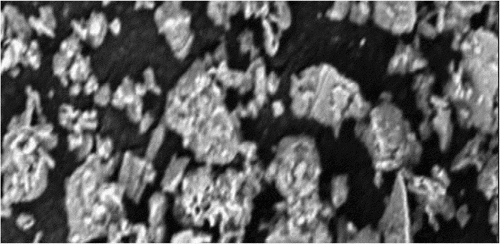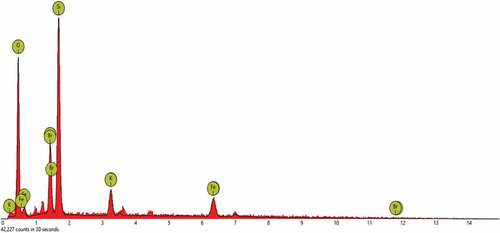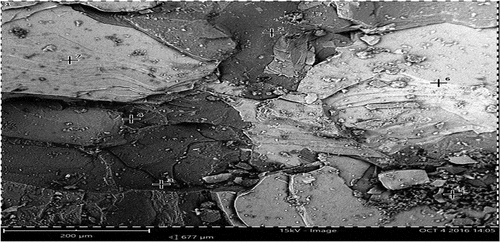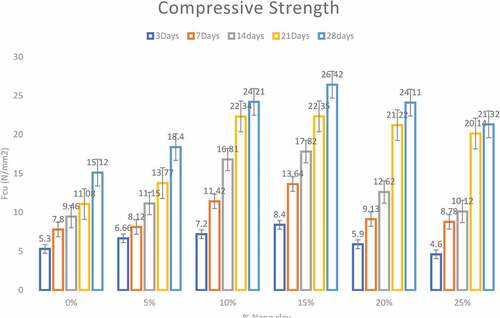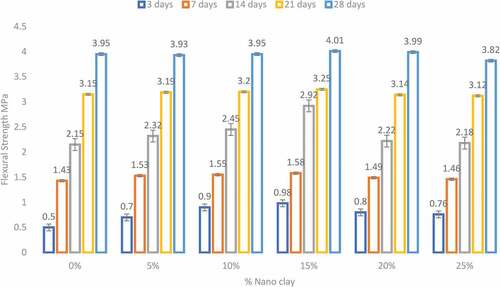 ?Mathematical formulae have been encoded as MathML and are displayed in this HTML version using MathJax in order to improve their display. Uncheck the box to turn MathJax off. This feature requires Javascript. Click on a formula to zoom.
?Mathematical formulae have been encoded as MathML and are displayed in this HTML version using MathJax in order to improve their display. Uncheck the box to turn MathJax off. This feature requires Javascript. Click on a formula to zoom.Abstract
Stormwater affects the economic situation of the environment, changes the land use, which also affects the ecosystem. Consequently, this affects the pavement condition of the road and lead to both structural and functional pavement defects. In a bid to proffer solution to the harmful effects of stormwater and reduce the cost of pavement construction in track with sustainability, this research utilized nano clay in the development of permeable concrete. The nano clay was used as a partial replacement for cement. It was dehydroxylated at 720°C; the characterization and particle geometry was done using the XRF equipment. The de-hydroxylated nano clay was used as a partial replacement for cement at 5, 10, 15, 20 and 25%. Correspondingly, six samples of concrete were developed. The mechanical properties (compressive and flexural strength) of the permeable concrete was assessed at 3, 7, 14, 21 and 28 days. Additionally, the porosity of the concrete was determined using Archimedes principle. The result of the research showed that using nano clay replacement at 15% gave a flexural strength of 4.01MPa. This is lower than the required specification of 4.27Mpa—4.5MPa for pavement construction at 28 days and 4.5Mpa and above for airfield pavement. The porosity test using Archimedes principle showed a satisfactory result. This proves the efficiency of the concrete for stormwater control. Therefore, this concrete is recommended for use in the design and construction of low axle or low trafficked road for stormwater control and aquifer recharge based on the flexural strength.
PUBLIC INTEREST STATEMENT
The construction of concrete and asphaltic concrete infrastructure involves the use of airtight, watertight, airproof and waterproof material which impedes the percolation of water to the aquifer for groundwater recharge. To this end, it becomes difficult for rainwater to percolate and therefore are not useful for aquifer recharge. This research developed a sustainable permeable concrete pavement for storm water control by the utilization a nanoclay as a partial replacement for cement. The mechanical properties of the developed concrete were assessed at different ages. Additionally, the porosity of the concrete was also determined using Archimedes principle. The result of the research showed that using nano clay replacement at 15% gave a flexural strength of 4.01MPa and a satisfactory porosity result. The development of this pavement is a positive way forward for stormwater management and aquifer recharge. It is a viable technology in the reduction of stormwater runoff.
1. Introduction
The negative effect of stormwater is encompassing. It can destroy properties and harm the life of man and animal through the impact of storm surge. This could also be in the form of snow or heavy rainfall. It affects the economic situation of the environment, changes in land use which also affects the ecosystem. Consequently, this, to a large extent, affects the pavement condition of the road and leads to both structural and functional pavement defects. In a bid to proffer a solution to this problem, the permeable pavements were developed as a form of open-graded road.
Permeable pavements are also known as porous or pervious, gap-graded or enhanced porosity concrete pavements; it originated in Europe about four decades ago (Ghafoori & Dutta, Citation1995a, Citation1995b, Citation1995c). The first construction was like a form of grass or open aggregate pavements. Other developments involved the use of concrete technology (ACPA: American Concrete Pavement Association, Citation1999; Ghafoori & Dutta, Citation1995a). The research of Hein and Smith (Citation2011) avowed that interlocking concrete block pavers were also adopted in the design of this special type of pavements. The most popular application of this type of concrete is in the design and construction of roads. However, some researcher has used it as a structural material in the construction industry. Other applications of this concrete involve the construction of parking lots, sidewalks, pathways, tennis courts, patios etc.
From the environmental perspectives, Brattebo and Booth (Citation2003), Collins et al. (Citation2008), and TRCA (Citation2008) asserted that the design of this pavement could be effective in pollutant removal such as nitrogen, phosphorous, total suspended solids. However, it is not effective in the removal of salts, metals, nutrients etc. The research of Tennis et al. (Citation2004) stated that the principle behind the operation of this concrete is by capturing rainwater when it seeps into the ground. This helps in groundwater recharge meeting up with the European Protection Agency (EPA).
There are two main factors involved in the design of pervious concrete, which are the hydraulic properties and mechanical properties. The research of the authors in showed previous research on the use of permeable concrete by varying some notable characteristics using sustainable materials and purpose.
Table 1. Batched samples
Previous Studies on pervious concrete
The choice nano clay was adopted in this research because of its unique pozzolanic ability infrastructural development (Ayobami et al., Citation2018; Busari et al., Citation2019) and useful life cycle ability Praticò et al. (Citation2020) with satisfactory global energy requirement (Nanjegowda & Biligiri, Citation2020).
Nano clay is said to be one of the most efficacious pozzolans in the concrete industry. It is deliberately fabricated and not solid waste material. It is regarded as an anhydrous calcined clay formed from heating mineral kaolinite clay (Aiswarya et al., Citation2013; Ayobami et al., Citation2018; Hisham, Citation2010; Pacheco et al., Citation2011). Nano clay was used in this research for the development of sustainable, cost-effective permeable pavement for stormwater control.
However, the hydraulic properties of permeable concrete can also be affected by the testing methods as avowed by (Borst & Brown, Citation2014; Li et al., Citation2013; West et al., Citation2016).
This research aims to utilize a sustainable, naturally occurring supplementary cementitious material in the development of porous concrete for sustainable pavement construction for stormwater control.
2. Methodology
2.1. Materials
Nano clay was obtained from Ekiti State Nigeria in the raw form, the solid waste particles were removed, and the sample was pulverized to reduce the size. The aggregates used for this experimental research was obtained in Ado-Odo Ota Local government in Ogun State Nigeria, 42.5 R grade of cement was also purchased in the open market at the same place. Portable water free from harmful material was used in batching the concrete.
2.2. Sample preparation
The Nano clay was de-hydroxylated at 720°C at the foundry laboratory of Covenant University Ota. It was then kept in an airtight container. This was used as a partial replacement for cement in the design of a sustainable porous pavement. The particle geometry of the material was also done to establish the pozzolanic properties of the material. The aggregates were physically examined to be sure that they are free from deleterious materials.
2.3. Methods
Six samples of porous concrete were developed at 0, 5, 10, 15, 20 and 25% Nano clay replacement of the concrete with a water-cement ratio of 0.35 and aggregate cement ratio of 5:1 (). The mix proportion is as shown in .
Table 2. Concrete mix design
The concrete was placed in 150 mm X 150 mm X 150 mm cube for compressive strength test according to ASTM C168. The flexural strength test was done using 150 × 150 X 450 mm mould. The concrete samples were cured for 3, 7, 14, 21, 28 and 56 days. The porosity of the concrete was assessed using EquationEquation 1Equation1
Equation1 .
where,
Vr = porosity (%),
W1 = weight under water (g),
W2 = oven dry weight (g),
Vol = volume of sample (m3),
ρw = density of water (g/m
3. Result and discussion
The Nano clay was characterized using XRF, which is a routine non-destructive test for assessing the chemical components of minerals using the wavelength-dispersive spectroscopic principles (). The analysis showed the presence of ten (10) oxides viz: SiO2, Al2O3, Fe2O3, MgO, CaO, K2O, TiO2, SO3, K20, and P2O5. The clay has a high amount of silica oxide (60%) and a lower percentage of Aluminum oxide (23.11%) this agreed with the outcome of the research of Jamo and Abdu (Citation2014) and Aroke and El-Nafaty (Citation2014). The XRF analysis revealing the oxide composition is as shown in while the microstructural analysis is shown in .
Table 3. XRF result of the nano clay
In order for the material to be classified as Class N (raw or calcined natural pozzolan) as defined by ASTM C618 (ASTM-C618-17, 2017), some of the chemical requirements that need to be met are (SiO2+ Al2O3+ Fe2O3)≥70.0%, SO3 ≤ 4.0%, moisture content ≤3.0%, and LOI content ≤10%. Based on the specification in , the material can be thus classified as a raw or calcined natural pozzolan.
3.1. Elemental composition of the aggregates
The elemental composition of the coarse aggregate was done to show the elements with the highest percentage that may inhibit the hydration process. This was done in a bid to further explain the interaction between the elements in the concrete mix (). The result of the elemental composition showed that the coarse aggregate was free from deleterious materials except for Iron which had a low percentage.
Microstructural Analysis
The result of the micro-structural assessment displaying the edge conditions is as shown in (). From the diagram, aggregate is rough-textured, and this may affect the water/cement ratio based on AASHTO M80, (American Association of State Highway and Transportation Officials (AASHTO) M 6, Citation1989) specification. The microstructural assessment implies that the aggregates may have a higher affinity for the cement to maintain the w/c ratio.
3.2. Mechanical properties
3.2.1. Compressive strength test
The compressive strength of the open-graded concrete is as shown in . From the result, it was shown that the strength increased up to 15% addition of the Nano clay. Afterward, the concrete strength began to reduce. However, the compressive strength is not as high as the result of normal concrete and self-compacting concrete (0% nano clay), as revealed by Busari et al. (Citation2019). However, it is within the specified compressive strength for rigid pavement construction, as indicated by AASHTO, Citation1993.
3.2.2. Flexural strength
The result of the flexural strength followed a similar pattern with the compressive strength (). Based on the result, a flexural strength of 4.01 was obtained, which is lower than the specified flexural strength for road construction as specified by AASHTO, (American Association of State Highway and Transportation Officials (AASHTO), Citation1993) and MODoT. Consequently, this type of concrete with concrete grade is recommended in the construction of rigid pavements for light traffic or low axle roads.
3.2.3. Porosity of the concrete sample
The porosity of the Nano clay porous concrete was assessed using the water displacement method. This unique method adopts the Archimedes principle relating to buoyancy. The dry mass, submerged, and total volume of the hardened concrete was determined at an early age and at maturity (). This was calculated using EquationEquation 1Equation1
Equation1 .
At maturity, physical observation showed that the pores allow water to percolate into the soil to filter out pollutants, which will invariably recharge the water table. This proves the efficiency of the concrete for stormwater control.
3.3. Pavement application
The surface of roadways should be stable and non-yielding to allow the wheel loads of road traffic to move with the least possible rolling resistance. Therefore, in pavement construction such as highway and airport runway, the flexural strength of concrete is considered more important, as the stresses induced in concrete pavements are mainly flexural. Consequently, the flexural strength more often specified than compressive strength in the design of concrete mixes for pavement construction is quite low compared to the standard specified by AASHTO, (American Association of State Highway and Transportation Officials (AASHTO), Citation1993).
The strength result with the addition of nano clay showed that the compressive and flexural strength was satisfactory up to 15%. At higher percentage addition of the Nano clay, a decline in both the compressive and flexural strength was noticed. The strength criteria required by MoDOT, (2001) limit the 1-day and 28-day compressive strength of pavement to 19KN/mm2 and 28KN/mm2, respectively, as reported by Chang, (Chang et al., Citation2001). However, the result of the analysis showed that the compressive strength of all the samples batched could not achieve that compressive strength at an early age (3 days).
Additionally, the result of the analysis using Nano clay at 15% gave a flexural strength of 401MPa, which is lower than the required specification of 4.27Mpa—4.5MPa for pavement construction at 28 days and 4.5Mpa and above for airfield pavement.
Therefore, this concrete is recommended for use in the design and construction of low axles or low trafficked roads. The result of the porosity test using the Archimedes principle showed an improved result at maturity. Hence the concrete will be good for stormwater control.
4. Conclusion
This experimental research utilized Nano clay in the development of green permeable concrete for stormwater control. The Nano clay was de-hydroxylated at 7200C before using it as a partial replacement for cement in concrete production. Six concrete samples were batched. The mechanical properties and the porosity of the concrete were assessed. The result of the research showed that:
(i) Based on the result, a flexural strength of 4.01 was obtained, which is lower than the specified flexural strength for road construction as specified by AASHTO, (AASHTO, Citation1993) and MODot.
(ii) The porosity test using the Archimedes principle showed an improved result at maturity. Hence, the developed concrete will be good for stormwater control.
(iii) The strength result with the addition of nano clay showed that the compressive and flexural strength was satisfactory up to 15%.
(iv) At higher percentage addition 15% and above of the Nano clay, a decline in both the compressive and flexural strength was noticed.
(v) The result revealed that the porosity increased at maturity. This proves the efficiency of the concrete for stormwater control.
Additional information
Funding
Notes on contributors
Ayangbayi Damilola
Ayobami Busari is a Civil and Environmental Engineering researcher with PhD in Transportation Engineering Option. Her research covers transportation planning, operations,
design, and safety, pavement design and materials incorporating highway construction. She has
contributed to several areas of SustainablePavement Engineering and Transportation planning and travel demand modelling among others with several publications. Ayobami Busari is the
current chairman of Association of Professional Women Engineers in Nigeria (Ota Chapter).
Fadipe Olusola Olayemi
Ayobami Busari is a Civil and Environmental Engineering researcher with PhD in Transportation Engineering Option. Her research covers transportation planning, operations,
design, and safety, pavement design and materials incorporating highway construction. She has
contributed to several areas of SustainablePavement Engineering and Transportation planning and travel demand modelling among others with several publications. Ayobami Busari is the
current chairman of Association of Professional Women Engineers in Nigeria (Ota Chapter).
Roland Tolulope Loto
Ayobami Busari is a Civil and Environmental Engineering researcher with PhD in Transportation Engineering Option. Her research covers transportation planning, operations,
design, and safety, pavement design and materials incorporating highway construction. She has
contributed to several areas of SustainablePavement Engineering and Transportation planning and travel demand modelling among others with several publications. Ayobami Busari is the
current chairman of Association of Professional Women Engineers in Nigeria (Ota Chapter).
References
- ACPA: American Concrete Pavement Association. (1999). Construction of Portland cement concrete pavements, participant’s manual. FHWA HI-96-027, AASHTO/FHWA/INDUSTRY joint training. Federal Highway Administration, United States Department of Transportation.
- Aiswarya, S., Prince, A. G., & Dilip, P. (2013). A study on the strength of concrete with partial replacement of cement with quarry dust and metakaolin. Engineering Science and Technology: An International Journal, 3(3), 46–10.
- American Association of State Highway and Transportation Officials (AASHTO). (1993). Guide for design of pavement structures. AASHTO.
- American Association of State Highway and Transportation Officials (AASHTO) M 6. (1989). Standard specification for fine aggregate for portland cement concrete. AASHTO.
- Aroke, U. O., & El-Nafaty, U. A. (2014). XRF, XRD and FTIR properties and characterization of HDTMA-Br surface modified organo-kaolinite clay. International Journal of Emerging Technology and Advance Engineering, 4(4), 817–825.
- ASTM C618-17. (2017). Standard specification for coal fly ash and raw or calcined natural pozzolan for use in concrete. ASTM International. www.astm.org
- Ayobami, B., Joseph, A., & Bamidele, D. (2018). Mechanical properties of de-hydroxylated kaolinitic clay in self-compacting concrete for pavement construction. Silicon, 211, 408-415.
- Borst, M., & Brown, R. A. (2014). Chloride released from three permeable pavement surfaces after winter salt application. JAWRA Journal of the American Water Resources Association, 50(1), 29e41. https://doi.org/10.1111/jawr.12132
- Brattebo, B. O., & Booth, D. B. (2003). Long-term stormwater quantity and quality performance of permeable pavement systems. Water Research, 37(18), 4369–4376. https://doi.org/10.1016/S0043-1354(03)00410-X
- Busari, A., Dahunsi, B., & Akinmusuru, J. (2019). Sustainable concrete for rigid pavement construction using de-hydroxylated Kaolinitic clay: Mechanical and microstructural properties. Construction and Building Materials, 211(11), 408–415. https://doi.org/10.1016/j.conbuildmat.2019.03.170. (ISI, Scopus).
- Carsana, M., Tittarelli, F., & Bertolini, L. (2013). Use of no-fines concrete as a building material: Strength, durability properties and corrosion protection of embedded steel. Cement and Concrete Research, 48, 64–73. https://doi.org/10.1016/j.cemconres.2013.02.006
- Chang, Q., Chen, W. G., Chang, Q., Lin, Y., Meer, A., West, A. E., & Griffith, E. C. (2001). Investigation of fiber reinforced polymer dowel bars in rigid pavement. http://www.books.com
- Collins, K. A., Hunt, W. F., & Hathaway, J. M. (2008). Hydrologic comparison of four types of permeable pavement and standard Asphalt in Eastern North Carolina. Journal of Hydrologic Engineering, 13(12), 1146–1157. https://doi.org/10.1061/(ASCE)1084-0699(2008)13:12(1146)
- FHWA. (2001). MAG internal truck travel survey and truck model development study appendix.
- Ghafoori, N. D., & Dutta, S. (1995a). Building and nonpavementapplications of no-fines concrete. Journal of Materials in Civil Engineering, 7(4), 286–289. https://doi.org/10.1061/(ASCE)0899-1561(1995)7:4(286)
- Ghafoori, N. D., & Dutta, S. (1995b). Laboratory investigation ofcompacted no-fines concrete for paving materials. Journal of Materials in Civil Engineering, 7(3), 183–191. https://doi.org/10.1061/(ASCE)0899-1561(1995)7:3(183)
- Ghafoori, N. D., & Dutta, S. (1995c). Development of no-finesconcrete pavement applications. Journal of Transportation Engineering, [ (13) (PDF) Hydrologic Properties of Pervious Concrete]. 121(3), 283–288. https://www.researchgate.net/publication/258808906_Hydrologic_Properties_of_Pervious_Concrete
- Hansen, M. R., & Phillips, C. (2010). Pervious concrete development in rapid city, South Dakota, USA. Proceeding of an International Conference on Concrete Under Severe Conditions, Merida, 7-9 June 2010, CRC Press, Taylor & Francis group, Vol. 2, pp. 131–1437.
- Hein, D. K., & Smith, D. R. (2011). Development of a design system for permeable interlocking concrete pavement. Proceedings of the National Low Impact Development Conference. North Carolina State University, College of Biological and Agricultural Engineering, Raleigh, NC.
- Hisham, M. K. (2010). Influence of metakaolin on the resistivity of cement mortar to Magnesium chloride solution. Ceramics, 54(4), p325–333.
- Jamo, H. U., & Abdu, S. G. (2014). Structural analysis and surface morphology kaolin. Science World Journal, 9(3), 29–30.
- Li, H., Harvey, J. T., Holland, T. J., & Kayhanian, M. (2013). The use of reflective and MoDOT (2001). Research development and technology: summary report. Missouri Department of Transportation.
- Morgenroth, J. (2011). Root growth response of Platanus orientalis to porous pavements. Arboricult. Urban Forest., 37(2), 45–50.
- Nanjegowda, V. H., & Biligiri, K. P. (2020). Recyclability of rubber in asphalt roadway systems: A review of applied research and advancement in technology. Resources, Conservation and Recycling, 155, 104655. 0921-3449. https://doi.org/10.1016/j.resconrec.2019.104655
- Pacheco, T. F., Arman, S., & Said, J. (2011, Rabat-Morocco, November 23-25). Using metakaolin to improve the compressive strength and the durability of fly ash-based concrete. International Seminar, Innovation, and Valorization in Civil Engineering & Construction Materials, 98–102.
- Praticò, F. G., Giunta, M., Mistretta, M., & Gulotta, T. M. (2020). Energy and environmental life cycle assessment of sustainable pavement materials and technologies forurban roads. Sustainability, 12(2), 704. https://doi.org/10.3390/su12020704
- Rasiah, S., & Yukari, A. (2010, August). Environmentally friendly pervious concrete for sustainable construction. Conference: The 35th Our World in Concrete & Structures.
- Shackel, B. (2006). 8th International Conferce on Concrete Block Paving, November 6-8, 2006, California Usa Design of Permeable Paving Subject to Traffic.
- Shah, D. S., Pitroda, J., & Bhavsar, J. J. (2013, August). New era for rural road pavement. International Journal of Engineering Trends and Technology (IJETT) 4 8. 2231–5381 http://www.ijettjournal.org 3496 Pervious Concrete
- Shen, S., Burton, M., Jobson, B., & Haselbach, L. (2012). Pervious concrete with titanium dioxide as a photocatalyst compounds for a greener urban road environment. Construction and Building Materials, 35, 874–883. https://doi.org/10.1016/j.conbuildmat.2012.04.097
- Tennis, P., Leming, D., Michael, L., & Akers, D. (2004). Pervious concrete pavements, EB302.02. Portland Cement Association, Skokie, Illinois, and National Ready Mixed Concrete Association.
- TRCA. (2008). Performance evaluation of permeable pavement and a bioretention swale, seneca college, King City, Ontario, Final Report, Toronto and Region Conservation Authority. http://www.sustainabletechnologies.ca/Portals/_Rainbow/Documents/Exec%20Summary+Cover.pdf
- Vázquez-Rivera, N. I., Linoshka Soto-Pérez, J. N., St John, S., & Hwang, S. (2015). Optimization of pervious concrete containing fly ash and iron oxide nanoparticles and its application for phosphorus removal. Construction and Building. Material, 93, 22–28. https://doi.org/10.1016/j.conbuildmat.2015.05.110
- West, D., Kaye, N. B., Putman, B. J., & Clark, R. (2016). Quantifying the Non-linear hydraulic behavior of pervious concrete. Journal of Testing and Evaluation, 44(6), 2172e218. https://doi.org/10.1520/JTE20150054

